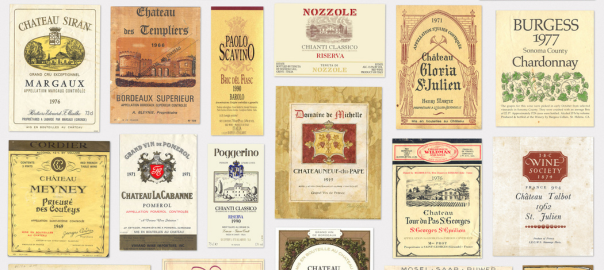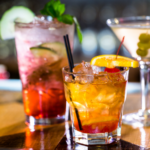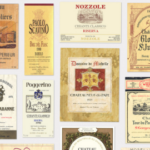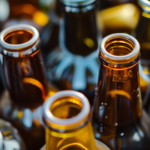Have you ever felt like a detective, trying to decipher the mysteries hidden behind a simple bottle label? Well, get ready to become the Sherlock Holmes of the wine world. Today, we’re going to reveal the secrets to decoding a label without a magnifying glass or a pipe, because yes, every word and symbol is a piece of the jigsaw that can reveal the hidden delights of your bottle.
Key Takeaways
- Understanding wine labels can transform your wine selection experience from a guessing game into an informed choice.
- Knowing the difference between Old World and New World wines can help you predict the flavor profile of the wine.
- The vintage of a wine can significantly impact its taste, with certain years producing higher quality wines due to favorable climate conditions.
- Recognizing reputable producers and understanding terms like ‘estate bottled’ can guide you to better quality wines.
- Quality indicators and certifications on wine labels, such as organic or biodynamic labels, can provide insights into the wine’s production methods and overall quality.
Understanding the Basics of Wine Labels
Wine labels are packed with information that can seem overwhelming at first glance. However, once you know what to look for, they become much easier to understand. Here are the primary components you’ll find on most wine labels:
Key Elements to Look For
Understanding wine labels can transform your wine selection experience from a guessing game into an informed choice. This guide will help you decipher the key elements on a wine label, including alcohol content, growing region, bottle volume, wine name, quality, type, producer, variety, and vintage. With this knowledge, you’ll be able to make more confident and satisfying wine choices.
Common Terminology Explained
Have you ever felt like a detective, trying to decipher the mysteries hidden behind a simple bottle label? Well, get ready to become the Sherlock Holmes of the wine world. Today, we’re going to reveal the secrets to decoding a label without a magnifying glass or a pipe, because yes, every word and symbol is a piece of the jigsaw that can reveal the hidden delights of your bottle.
Importance of Label Design
Put a label on it! Now that we know what these designations mean, you may be wondering how they will come up. Turns out, they’ll come up a lot! Not on a test, luckily. But, they’ll be prevalent at your local wine shop and on wine lists. And, if you can navigate the Bourgogne section, all the other sections become a cake walk.
Decoding Regional Information
Understanding the region of production is crucial when decoding the label of a wine bottle. The region tells you about the terroir, climate, and local winemaking traditions. Wines from the same region often share common characteristics, which helps you to anticipate the style of wine. This “Region+” naming tells you that the wine wasn’t grown just anywhere in the region, but in that specific named geographical area. And that can be very interesting information, because those little terroirs may make quite different wines from the region as a whole.
The appellation is the first guarantee of a wine’s quality, designating its geographical origin. It indicates a certain quality, tradition, or style of wine. It is found just below the region.
Interpreting Wine Varietals and Blends
Single Varietal Wines
Single varietal wines are made primarily from one type of grape. This is often indicated on the label, making it easier for consumers to identify the wine’s primary flavor profile. For example, a bottle labeled as “Pinot Noir” will predominantly feature the characteristics of that grape. Understanding these labels can help you choose a wine that suits your taste preferences.
Popular Blends and Their Characteristics
Blended wines combine multiple grape varieties to create a more complex flavor profile. The grape varieties are always listed in the order of their predominance, i.e., from the most present to the least present. For instance, a Bordeaux blend might include Cabernet Sauvignon, Merlot, and Cabernet Franc. Each grape contributes its unique characteristics, resulting in a harmonious and balanced wine.
Reading Grape Information
The grape varieties used to produce the wine are essential. Check the back label to find out which grape varieties are present. Each variety has its own unique characteristics, and the combination of grape varieties influences the aromatic and taste profile. In red wines, the color intensity can give you a hint about the type of grape used. For example, lighter colors indicate thinner grape skin varieties like Pinot Noir, Nebbiolo, and Grenache, while a deeper color points to thicker grape skin types like Cabernet Sauvignon, Merlot, or Shiraz.
When exploring new wines, don’t hesitate to try blends. They often offer a unique tasting experience that single varietal wines might not provide.
The Role of Vintage in Wine Labels
What Vintage Means
The vintage on a wine label indicates the year in which the grapes were harvested. This is a crucial piece of information as it can reveal a lot about the wine’s character and quality. Climatic conditions vary from year to year, influencing the quality of the grapes and, consequently, the wine. However, it’s important to remember that the skill of the winemaker can also significantly impact the final product.
How to Identify Good Vintages
Identifying good vintages involves understanding the climatic conditions of the year in question. Generally, years with favorable weather conditions produce better grapes, leading to higher-quality wines. Here are some tips to identify good vintages:
- Research the climatic conditions of the wine region for the vintage year.
- Look for reviews and ratings from reputable wine critics.
- Consider the reputation of the winery and its consistency in producing quality wines.
Impact of Climate on Vintage Quality
Climate plays a significant role in determining the quality of a vintage. Factors such as temperature, rainfall, and sunlight during the growing season can all affect the grapes’ development. For instance, a warm, dry growing season often results in ripe, flavorful grapes, while a cooler, wetter season might produce grapes with higher acidity and lower sugar levels.
Remember, the vintage tells us not just the year the wine was made, but also offers insights into the environmental conditions that shaped its development.
Understanding the role of vintage in wine labels can greatly enhance your wine selection process, helping you choose wines that align with your taste preferences and expectations.
Producer and Winery Information
Knowing the producer can be one of the most important aspects of selecting a good wine. Just as you might trust a movie produced by Spielberg or Coppola, recognizing reputable wine producers can guide you to quality wines. Familiarize yourself with well-known producers to make quicker and more confident choices.
Recognizing Reputable Producers
The producer is the entity that stomped the grapes into submission. It’s usually the name of the winery or vineyard. Familiarize yourself with well-known producers to make quicker and more confident choices.
Understanding Estate Bottled Wines
Estate-bottled designations indicate that the wine was produced and bottled on the same estate where the grapes were grown. This often signifies a higher level of control over the winemaking process and can be a mark of quality.
The Story Behind the Winery
Many wineries have rich histories and unique stories that add to the allure of their wines. From family-owned vineyards to innovative new producers, understanding the background can enhance your appreciation of the wine. For all imported wines, the name and address of the importer, agent, sole distributor, or other person responsible for the importation must appear on the label.
Alcohol Content and Other Technical Details
Understanding the technical details on a wine label can greatly enhance your appreciation and selection process. Here, we delve into some of the key technical aspects you should be aware of.
Reading Alcohol by Volume (ABV)
The alcohol content is usually one of the easiest elements to spot. It is typically expressed as a percentage, often ranging from 12% to 14%. In the United States, table wines must have an alcohol content between 7% and 14%. The higher the alcohol content, the fuller-bodied the wine.
Understanding Residual Sugar Levels
Residual sugar levels indicate the amount of sugar remaining in the wine after fermentation. This can range from bone dry to very sweet. Knowing the residual sugar level can help you predict the wine’s sweetness and pair it better with food.
Other Technical Indicators
Other technical details on a wine label can include the bottling date, the identity and address of the bottler, and sometimes even the type of oak used for aging. These details can provide insights into the wine’s quality and aging potential.
The degree of alcohol is an indication of the strength of the wine, and gives information about the ripeness of the grapes.
For those interested in beer styles or whiskey terminology, understanding these technical details can also enhance your overall knowledge and appreciation of alcoholic beverages.
Quality Indicators and Certifications
Recognizing Quality Seals
When it comes to assessing wine quality, medals and scores are often the first indicators that catch the eye. These accolades, awarded by critics and in competitions, signify a recognition of excellence. However, it’s important to remember that taste is subjective, so let these awards guide, but not dictate, your choice.
Understanding Organic and Biodynamic Labels
In the realm of wine, terms like “organic” and “biodynamic” are more than just buzzwords. They indicate that the wine has been produced following specific agricultural practices that are environmentally friendly. Organic wines avoid synthetic chemicals, while biodynamic wines adhere to a holistic approach, considering the vineyard as an ecosystem.
Deciphering Wine Ratings and Reviews
Wine ratings and reviews can be a helpful tool in selecting a bottle. These ratings, often given by renowned critics, provide a snapshot of the wine’s quality. However, just like with medals and scores, it’s essential to remember that these ratings are subjective. Trust your instincts and personal preferences when making a choice.
Look beyond the label: Flashy labels and brand names don’t always guarantee quality. While some established brands offer reliable options, supermarket own-label bottles can be hidden gems, often representing excellent value for money. Look for awards or certifications displayed on the label, but remember these aren’t a foolproof guarantee.
Our commitment to quality is reflected in our numerous certifications and industry-recognized quality indicators. Discover more about our standards and how we ensure the best for our customers. Visit our website to learn more and see what we’re up to!
Conclusion
Decoding wine labels can transform your wine selection experience from a guessing game into an informed choice. By understanding the key elements such as alcohol content, growing region, bottle volume, producer, varietal content, and quality ratings, you can make more confident and satisfying wine choices. Remember, the best wine is the one you enjoy the most, regardless of its label or price. Cheers to your next great bottle!
Frequently Asked Questions
What are the key elements to look for on a wine label?
Key elements to look for on a wine label include the producer’s name, the wine’s region of origin, grape varietal, vintage, alcohol content, and any quality certifications or seals.
What does ‘vintage’ mean on a wine label?
The term ‘vintage’ on a wine label refers to the year in which the grapes were harvested. It can give you an idea of the wine’s age and potential quality, as well as the climate conditions that year.
How do old world wines differ from new world wines?
Old world wines come from traditional wine-growing regions in Europe, such as France, Italy, and Spain, and often emphasize terroir and subtlety. New world wines come from regions like the USA, Australia, and South America, and are typically known for their bold flavors and innovation.
What is an appellation and why is it important?
An appellation is a legally defined and protected geographical indication used to identify where the grapes for a wine were grown. It is important because it often indicates specific quality standards and characteristics associated with that region.
How can I identify a good vintage?
To identify a good vintage, you can refer to vintage charts, wine reviews, and expert opinions that evaluate the quality of wines from different years based on weather conditions and other factors affecting grape growth.
What does ‘estate bottled’ mean?
‘Estate bottled’ means that the wine was made and bottled at the same estate where the grapes were grown, indicating a higher level of control over the winemaking process and often a higher quality wine.













